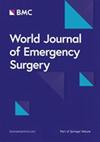Life-threatening event in laparoscopic hepatic surgery: Training curriculum on sudden hepatic artery haemorrhage
IF 5.8
1区 医学
Q1 EMERGENCY MEDICINE
引用次数: 0
Abstract
Exposure of the hepatic artery is a fundamental step in many surgeries, during which iatrogenic hepatic artery injury may occur. Although the incidence of hepatic artery haemorrhage is low, its occurrence can lead to life-threatening haemorrhage. It is difficult and dangerous to accumulate clinical experience in laparoscopic hepatic artery repair in actual patients, and simulation training models for laparoscopic hepatic artery repair are currently lacking. In this study, a 3D printed model was designed to simulate the training curriculum for sudden hepatic artery haemorrhage, but whether training with the 3D printed model could yield superior skill improvement for surgeons remained to be determined. A new 3D printed model was designed for this study. Surgeons from the General Surgery Department of Sir Run Run Shaw Hospital participated in this simulation training. The surgical performance of each model was compared, and the authenticity of the model was evaluated and mechanically tested. Experienced surgeons performed better on the 3D printed model. After repeated training, inexperienced surgeons showed significant improvement of their laparoscopic hepatic artery repair skills. The authenticity of the model was generally satisfactory, but shortcomings persisted in the mechanical testing of artery wall tearing, necessitating further improvement. Few studies have investigated laparoscopic simulation training for sudden hepatic artery haemorrhage. This simulation model distinguishes surgeons with different levels of experience and allows those with less experience to improve their laparoscopic hepatic artery repair skills through training on the model.腹腔镜肝脏手术中危及生命的事件:突发性肝动脉出血培训课程
暴露肝动脉是许多手术的基本步骤,在此过程中可能会发生肝动脉先天性损伤。虽然肝动脉大出血的发生率很低,但其发生可能导致危及生命的大出血。在实际患者身上积累腹腔镜肝动脉修补术的临床经验既困难又危险,目前还缺乏腹腔镜肝动脉修补术的模拟训练模型。本研究设计了一种3D打印模型来模拟肝动脉突发大出血的培训课程,但使用3D打印模型进行培训是否能使外科医生的技能得到更好的提高仍有待确定。本研究设计了一种新的 3D 打印模型。邵逸夫医院普通外科的外科医生参加了此次模拟训练。对每个模型的手术表现进行了比较,并对模型的真实性进行了评估和机械测试。经验丰富的外科医生在 3D 打印模型上的表现更好。经过反复训练后,经验不足的外科医生的腹腔镜肝动脉修补术技能有了显著提高。模型的真实性总体上令人满意,但在动脉壁撕裂的机械测试中仍存在不足,需要进一步改进。很少有研究对腹腔镜肝动脉突然出血的模拟训练进行调查。该模拟模型可区分不同经验水平的外科医生,让经验较少的外科医生通过模型训练提高腹腔镜肝动脉修复技能。
本文章由计算机程序翻译,如有差异,请以英文原文为准。
求助全文
约1分钟内获得全文
求助全文
来源期刊

World Journal of Emergency Surgery
EMERGENCY MEDICINE-SURGERY
CiteScore
14.50
自引率
5.00%
发文量
60
审稿时长
10 weeks
期刊介绍:
The World Journal of Emergency Surgery is an open access, peer-reviewed journal covering all facets of clinical and basic research in traumatic and non-traumatic emergency surgery and related fields. Topics include emergency surgery, acute care surgery, trauma surgery, intensive care, trauma management, and resuscitation, among others.
 求助内容:
求助内容: 应助结果提醒方式:
应助结果提醒方式:


